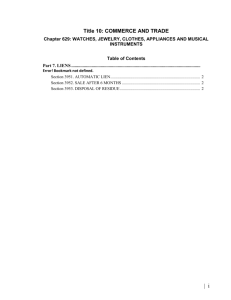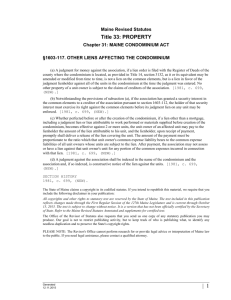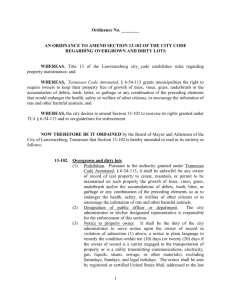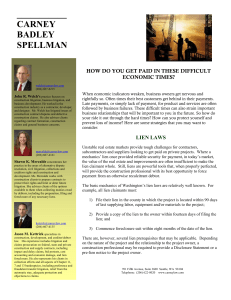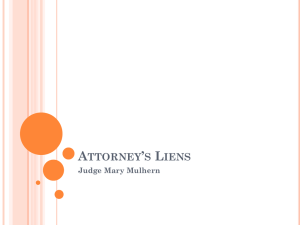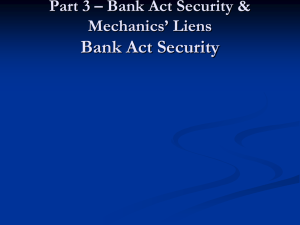Lien on Me? - Richards, Layton & Finger
advertisement
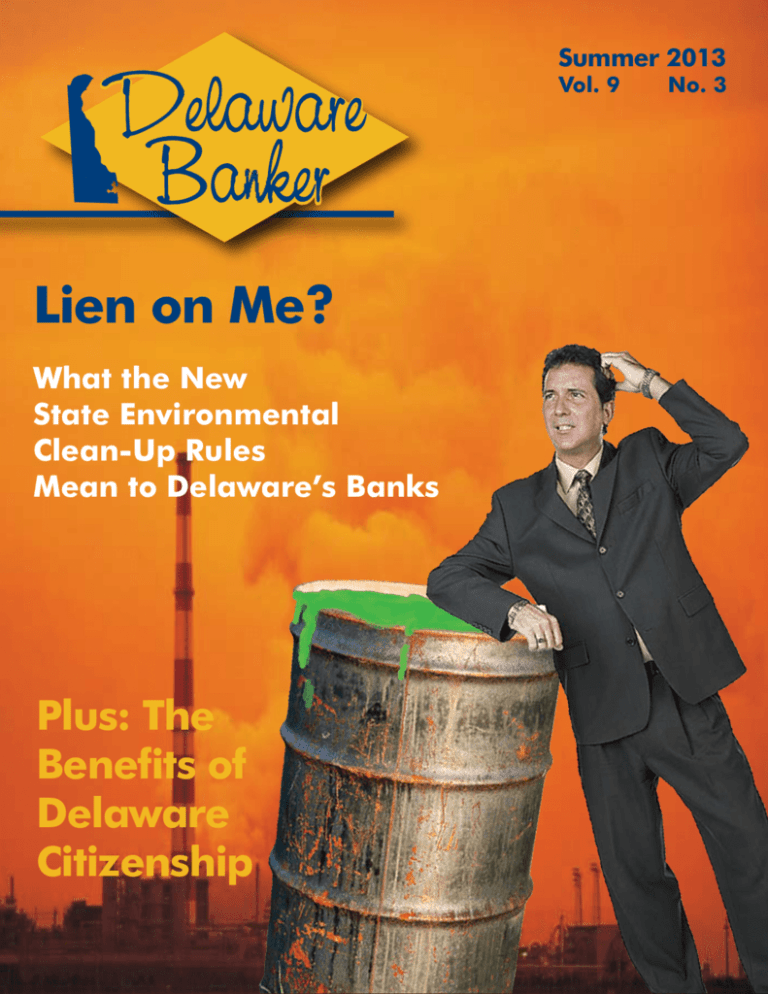
Summer 2013 Vol. 9 Lien on Me? What the New State Environmental Clean-Up Rules Mean to Delaware’s Banks Plus: The Benefits of Delaware Citizenship No. 3 Cover Story Lien on Me? Delaware Grants Authority to State Environmental Agency to Impose Environmental Liens To Recover Investigation and Clean-up Costs by Robert W. Whetzel and Todd A. Coomes Richards, Layton & Finger, P.A. I 10 Delaware Banker - Summer 2013 n the recent legislative session, Delaware took another step to require responsible parties to clean-up contaminated property by enacting environmental lien legislation. Delaware’s new environmental lien statute allows the State’s environmental agency, the Delaware Department of Natural Resources and Environmental Control (“DNREC”), to impose environmental liens on real property to recover its clean-up costs. While not a “super-priority” lien, a lien created under this legislation will have priority over “after-perfected” liens and encumbrances. Delaware’s Path to an Environmental Lien The environmental lien concept is not a new regulatory tool. Under federal law, the Comprehensive Environmental Response, Compensation and Liability Act (“CERCLA”) provides, in general, that all costs and damages for which a person is liable to the United States constitutes a lien in favor the United States on all real property and rights to such property which (i) belongs to the person and (ii) is subject to or affected by a removal or remedial action. (See 42 U.S.C. § 9607(l)(1)). CERCLA requires that the liable person must be given written notice of the potential liability, and the lien will be subject to the rights of any purchaser, holder of a security interest, or judgment lien creditor whose interest is perfected under state law before the notice is filed. (Id. § 9607(2)(B) and (3)). For many years, the Delaware Hazardous Substance Cleanup Act (“HSCA”) has allowed DNREC to place a lien by agreement with a prospective purchaser of contaminated property, when the property was acquired by a non-liable person and cleaned-up by the State. (See 7 Del. C. § 9105(c) (4)(c)). Significantly, Delaware law did not allow DNREC to unilaterally place a lien on a property at which it had expended funds to take remedial or other actions at HSCA sites or sites with leaking underground or aboveground tanks. DNREC’s lien authority clearly fell short of the federal lien authority, as recognized by Delaware’s Metachem Task Force in its May 2003 Report. The Metachem Task Force was formed due to concerns that the abrupt cessation and bankruptcy of the Metachem facility located in Delaware City, Delaware would impose significant financial and environmental burdens on the State and federal governments. Accordingly, the task force was directed to propose processes and policies to mitigate or avoid similar financial exposure to the State at other sites. One recommendation of the task force was to provide DNREC with the authority to impose liens on real property owned by parties responsible for the incurrence of clean-up costs, similar to the authority in CERCLA and in many other states. The task force specifically recommended that DNREC be allowed to impose the lien on any real or personal property in the State owned by the responsible party. The task force report also recommended that the lien provision be “carefully crafted” to ensure due process rights, including a judicial process to precede the imposition of the liens, and a procedure to extinguish the lien once circumstances so warranted. In its 2013 Delaware legislative session, the Delaware General Assembly took under consideration legislation to grant DNREC the environmental lien authority. Following the introduction of HB 95 in early 2013, the bill was reviewed and revised based on comments from interested stakeholders, including the Delaware Banker’s Association, the Delaware State Chamber of Commerce, and the Committee of 100. After several amendments to address issues in the original bill, the legislation was passed on June 27, 2013 and signed by Governor Markell on June 30, 2013. The synopsis of the legislation provides that the State has enacted environmental lien legislation to bring Delaware in line with a vast majority of its sister states and the United States with respect to environmental liens, and to provide a tool to protect the State’s treasury by recovering money expended by the State on contaminated sites. Delaware’s Environmental Lien Authority The environmental lien authority legislation allows DNREC to attach liens to properties with sites addressed under HSCA, as well as the Underground Storage Tank Act and the Jeffery Davis Aboveground Storage Act (collectively, the “Tank Acts”). While the legislation separately amends each of these statutes to provide the lien authority, the new lien provisions in each statute are essentially identical. Creating the Lien The legislation specifies how the lien arises and attaches. In general, costs related to any remedy or corrective action taken by DNREC for which a person is liable under HSCA or the Tank Acts will constitute a lien in favor of the State upon the real property where a cleanup takes place and which belongs to such person. The lien is for “reasonable” costs incurred by DNREC. The lien is limited to property “which belongs to such person” to limit the environmental lien authority to property owned by a person liable for cleanup costs. The lien provision is not intended for property owned by innocent land owners, brownfield redevelopers and other persons who are not liable for the cleanup costs. Before the lien will attach to property owned by a liable person, DNREC must: (i) incur costs at the property, (ii) file a notice of lien (“Notice of Lien”) with the Office of the Recorder of Deeds in the county in which the property is located 30 days prior to the effective date, and (iii) give notice of the lien to all record owners of the property and persons holding liens or security interests of record 30 days prior to the effective date. The Notice of Lien is to state the amount of and basis for the lien, and DNREC is to make available the documentation on which a lien is based upon request. An environmental lien created under the new authority will have priority over all other liens and encumbrances perfected after the date such lien is perfected, except for those relating back to periods before the perfection. As a practical consideration for lenders holding security interests on affected properties, the important trigger point is most likely the date of the filing of the Notice of Lien. As such, title searches obtained for properties serving as collateral for loan transactions should be carefully reviewed for a Notice of Lien. The legislation provides that the lien may not be limited or discharged in a bankruptcy proceeding, and all obligations under the lien authority constitute regulatory obligations imposed by the State. The lien will continue until satisfied or (continued on p. 12) Environmental Liens (continued from p. 11) otherwise discharged, and once satisfied there is to be a notice of release filed by DNREC. No time period is specified for when DNREC must file this notice. Challenges to An Environmental Lien The lien legislation creates a series of checks for a potentially affected person to have notice of the lien and challenge the imposition of a lien. In addition to the notice provisions described above, the lien legislation provides that: • A substantially affected person has the right to contest the imposition of a lien to the Delaware Environmental Appeals Board; and, • An aggrieved person may bring equitable claims in the Delaware Court of Chancery to contest the imposition of a lien, including an action to quiet title. For any action seeking to contest or enforce a lien, the legislation states that the burden of establishing entitlement to such lien shall be consistent with the burden of proof applicable in an action brought by the Secretary pursuant to HSCA or the Tank Acts. The legislation also includes a process for bonding over liens that are in dispute. A substantially affected person challenging the lien may also discharge the lien upon payment into the Delaware Court of Chancery of a cash deposit (or entry of security in lieu of cash) while contesting the imposition of the lien. The party in interest must petition the Court for the discharge, specifically setting forth by affidavit which parts of the claim are disputed and which are not disputed. The non-disputed part of the claim must be paid to DNREC before the lien is discharged. If the Court of Chancery concludes that the disputed portion of the claim has been grossly overstated by the affiant, the Court may, in its discretion, award damages in an amount up to twice the figure stated by the affiant to be disputed. The Court, after notice and hearing, may (i) require the increase or decrease of any deposit or security; (ii) strike off security improperly filed; or (iii) permit the substitution of security and enter an exoneration of security already given. This process could come into play in the context of a financing transaction where a Notice of Lien was filed and the substantially affected person is actively challenging the lien, but in the interim is still dealing with an encumbrance on the title to their property. By utilizing this process the lien could be bonded over while the dispute is litigated allowing a mechanism for a title company to potentially remove the Notice of Lien as an exception to title, potentially allowing the financing transaction to close. 12 Delaware Banker - Summer 2013 Expanded Environmental Lien Right As suggested by the Metachem Task Force, the environmental lien authority provided to DNREC may go beyond the environmentally impacted property, in certain circumstances. DNREC has authority to impose a lien on any real property in the State owned by the liable person if the State cannot recover its full costs from the lien on the impacted property. In order to do so, DNREC must determine that the funds projected to be available to satisfy the lien will be insufficient to permit the State to recover its full costs, and DNREC must file a petition in the Delaware Court of Chancery seeking to impose the additional lien (or liens). The petition must describe with particularity the real property to which the requested lien will attach, and the Court of Chancery is to conduct a hearing as to whether to grant the petition, notice of which is to include record owners of the real property subject to the petition and any person holding a lien or perfected security interest in such property. Implementation and Use of the Lien While DNREC has stated that the use of environmental liens will be an action of last resort, the actual use of the environmental lien provision remains to be seen. Future developments in this area will significant for owners of potentially contaminated property, as well as developers and other prospective owners of industrial and commercial facilities and lenders that finance the acquisition or operations of those sites. Although DNREC has typically exercised discretion in the use of its enforcement tools at contaminated sites, the environmental lien could become the remedy of choice for recovering costs. The environmental lien legislation does not contain any express provision addressing the duration for the lien. By comparison, under CERCLA the federal lien continues until satisfied or it becomes unenforceable through the statute’s limitation period. (See 42 U.S.C. § 9607(l)(2)). For recovery of costs, these limitation periods are generally 3 years after the date of completion of a removal action or 6 years after the date of initiation of a remedial action. (See id. § 9613(g)(2)). The Delaware lien legislation does not contain an express time limitation, although such actions might be subject to the general three year limitations period under 10 Del. C. § 8106. In the absence of a time limitation, DNREC could potentially place liens on properties long after the incurrence of cleanup costs, without taking other enforcement action against the liable property owner or other potentially responsible parties. If these parties are not pursued, ultimately the other lienholders or future property purchasers may have to address any liens that have been perfected. This legislation will also add another layer onto environmental site due diligence for Delaware properties, as there will have to be a title search to determine if a lien has been perfected or whether one could arise in the future. While property records will contain notices of certain aspects of the lien, it may be, at best, difficult to determine the extent of remaining, unrecovered State costs for a property or whether a lien may be filed on a property in the future. DB Robert W. Whetzel, chair of the Richard, Layton & Finger, P.A.’s Litigation Department, practices in the general and commercial litigation area, with an emphasis on disputes relating to industrial facilities, petrochemical and refinery facilities, and technology. With extensive experience in state and federal court litigation and alternative dispute resolution matters, Bob’s recent cases include contract disputes relating to construction of industrial facilities, defense of utilities against power outage claims, and contract disputes relating to purchase of industrial goods. Todd Coomes concentrates his practice on litigation and regulatory matters involving environmental, energy and utility interests. He also represents clients in business transactions and litigation that relate to the purchase, sale or operations of manufacturing, industrial and other facilities. Todd counsels clients on compliance issues arising under federal and state environmental laws, including environmental permitting strategies and audits. He has represented clients in enforcement actions asserted by the United States Environmental Protection Agency and state environmental agencies, including negotiations arising from multimedia compliance investigations. Robert W. Whetzel is a director of Richards, Layton & Finger, P.A., Wilmington, Delaware, and Todd A, Coomes is counsel with the firm. Attorneys at Richards, Layton & Finger, including the authors, were involved in drafting the legislation discussed herein, but the opinions expressed in this article are those of the authors and not necessarily those of Richards, Layton & Finger or its clients.
